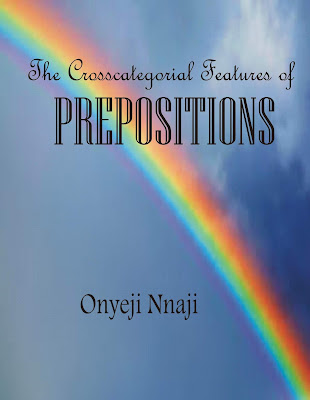The Meaning of "5" in the Igbo Cosmology - Onyeji Nnaji
Copied from: Cosmic Chain by Onyeji Nnaji
In the Igbo
cosmology, the word Isee is a definite symbolic word as revealed through
the Igbo language and culture. A human being has five fingers, five toes. The
hands and feet are fundamentals to the survival in life as they are necessary
in ensuring that man moves to places where he gets food and grapples on the
food to sustain his life. To this view, the rhetoric that binds vocatives in
the form of incantation (anchoring on the heart-lock: four) and the
concomitant reprisal in the manner of affirmation that holds the human life
bind to his original spiritual person, therefore defining existence and
essences are unified by the corresponding echo: Isee!!!!!
Therefore
it stands that anytime a prayer is said in the Igbo land, the attendants who would
want the fulfillment of the prayer unanimously affirmed the prayer by saying
Isee! Five then becomes the language of the spirit, the language of the creator
that indicates agreement to, not every sayings but those that carry creative
power, indicate affirmation. It is even obvious when it is demonstrated
dramatically as the Igbo affirm the prayers said in their midst. If a kolanut
is broken and the Igbo say prayers, as soon as he mentions the blessings or wishes
associated with lives, the attendants go in to affirm them thus: Isee! Then,
dramatically, everyone points his fingers towards the soil. Put in another way,
the spontaneity of the unanimous drama is an indication that Isee (five)
is associated with the soil which is represented in the mystic concept as the
primordial god, Ala.
Among the Igbo, the number five has great symbolic significance. If a kolanut is broken and it
has five lobes it means good luck to the sharer. It also refers to stability. Such a colanut is traditionally referred to as, "Orji Ikenga". Thus isee
reflects axiomatic values; five definite realization on which the life of every
Igbo rests. They are: life, children, wealth, peace and love (Ekwunife, 1990). Another
word for the meaning of an axiom could be simply, self evidence. The principal of
the axioms kept by the Igbo are derived from the natural law, and the Igbo
ascribed the source and making of these laws to the primordial goddess of the earth, Ala.
Ala is the moral concomitance of the natural law, and the exercise of authorities
binding on these laws by Ala gave the ancient Igbo the impetus to ascribe
reverence to Ala goddess as a primal god. This religious practice stood and still
stands the Igbo different from every other ancient worlds, races, tribes and people.
This primal goddess is represented everywhere among the Igbo communities with a
stepped earth, and the geometry is five. Significant enough, Eze Nri
clarifies that, in the days of creation, Chukwu Okike eminently started his creation
upon an anthill; the earth was covered by water. It was on this anthill that
the first man (believed to be the first ancestor of the Igbo race) landed via a rope from
the sky. From hence was the goddess Ala revered by the Igbo as the original being.
This ancient pact was replated concretely at Nsude by the prominent Nsukka Civilization of 500,000BC in a chain of pyramids. Nsukka civilization remains the most influential civilization globally. The problem we had in it's popularity was that the civilizarion was eluded. Egypt adopted this civilizarion in symbols. As a result, people only read their symbolic representations but devoid of their concrete meaning and referents. A civilizarion that touched the whole Africa of the ancient time with the merchant of iron, recorded by them all, but difficult to decipher and decoded by the modern society.
Egypt recorded this civilization in varying ways. Egyptian account of creation holds to this similar view alongside the Jewish Cabala. These later records intoned that God first raised a mound upon which He stood when He created all that was created. According to Egyptology, the pyramid in Saqqara was designed to commemorate this concept. Among the Jews of Israel, this culture – supposedly acquired from Egypt – is still celebrated with the gathering of sand to commemorate the same concept. The pyramid in Saqqara followed the same pattern to reveal the close relationship between the builders of the different pyramids at different places and time.
The mystery
surrounding the pyramid and the ideology for setting up the pyramid xrays the
history of the civilization of ancient Egypt herself. The code of the Giza pyramid reveals the culture of their origin. The mystic symbol is 3/2. This is not different from the "5" echoed by the Igbo tradition as the symbol of the earth (Ala). If you solve the above equation using Pythagoras theory, you will get the same result as "5". See the calculation below.
X = 9 -4 = 5
X = √5 = 2.24
Y = 2.24 × 2
Therefore, X + Y = 4.47
The base of the pyramid then is equal to
5 (by approximation).
Beyond controversy, every aspect of the Egyptian pyramid reveals a culture that was predominantly outside Egyp. Of course, the Egyptian Book of the Dead reveales that "Egyptian civilization is traced beyond Egypt". Nsukka is beyond Egypt.
Anothern unearthed tablet, Nag Hammadi, gave descriptions of the founders of Egypt and her civilizers in the following ways:
A) “kingless generation with no kingdom over them" because they are all kings (Igbo Enwe Eze).B) a people whose “most central symbol is the quadrangle” (the basic geometry of Igbo ichi).C) a people who “worship the Primal Goddess” (as Ana/Ala/Ani).D) a people among whom “the three entities Father, Mother and Child exist as perceptible speech having within it three names abiding in three nnn,” as in Nne, Nna and Nwa or Nwoke, Nwanyi and Nwata.E) “The First Sons of the true God--- the fourth generation, which is the most exalted, is kingless and perfect.” From creation, the Igbo was originally kingless and the call thselves Sons of God.
How we Know that Egyptian Pyramid is Associated with Nsukka Civilization
Hag Hammadi was
not the only proof of this. The ancestors of the Igbo race saw everyone
with the equal content of the same god-man spirit each person carried.
Egyptian records reveal this better It remarks
thus:
“In the beginning the beings had energy of royalty majesty,” literally a concept, idea or instinct which impinged itself in man and made him see himself as equal to his neighbour;” for they were all royalty”. That is the principle, and Egypt has the people of this principle as “the origin of world history and civilization.” Viz, that “all began with energy and energy is existence and the correct frequency of existence is the true definition of truth and love…”
This people were the teachers of the Egyptian knowledge of the old. The Igbo gained a settle lifestyle after they began to understand the principle of planting and harvesting – according to Eze Nri. That was why, An American anthropologist, Richard Henderson titled his work on Igbo history The King in Every Man.
Chesi (1985:7), emphasizing the potency of rituals in Africa, asserts thus “people say that in former times all men carried a share of the gods in them, and vice versa. The task of the ritual is to activate and to intensify these shares so as to enable man to be divine for a certain period of time.”
* The Pyramid was a Photocopy
Emily Teeter in the book, "Before the Pyramids", asserts vividly that the “direct evolution of civilization in the Nile Valley from the Paleolithic time through Predynastic Egypt to a fully-fledged monumental civilization was already well attested.” Pointing at the most relevant source of the pyramid at Saqqara, he said:
The top register on the right-hand side contains a complex pictorial scene: an abbreviated version of more monumental forms of depiction, of a kind perhaps already rendered in stone relief, but hardly preserved from these early periods (Alexanian 1998). It depicts part of a ceremony later enacted in the step pyramid complex of Djoser at Saqqara (Before, 101).
Be mindful of the highlights in blue. Images found in the temple at Abydos which point towards the source of the Egyptian pyPyram are shown below,
These are sea creature, but only significant because of its distinct shapes. The shape is distinctively attractive because of the idea it represented. One of the bronze unearthed in Igbo Ukwu has this same structure and represented the same idea.
The idea they represented was “later enacted in the step pyramid complex of Djoser at Saqqara”. A pyramid of five distinct layer or steps with an indication of optimality and termination at the top; constructed at a stone cleft in Nsude. The hope of its preservation was stressed here, due to the fact that it was built of well knitted clay. The sea creature was significant because it served as a link between the Saqqara pyramid and its original source in Igbo land.
* Egyptian Documents Show that the Civilizers Came from Outside Egypt
The discovering
made in Egypt is shading more light on the proof that the civilizers of Egypt
were not Egyptians. It also indicates that it was possible the same civilizers
were the dynastic race. Citing Petrie (1939, p.153) on the history of Egyptian
civilization, Teeter asserts thus,
Petrie was a devotee of the “dynastic
race” theory, believing that the founders of Egyptian civilization came from
outside the country.
Geographically, we came to the knowledge of these civilizers following the exposition given by the Egyptian Book of the Dead. It relates that the home of the Egyptian civilizers is at the place of the rising sun: particularly, at “the northern door”, Nsukka is at Northern door from Igbo land; it is at present in Enugu State of Nigeria. Nsukka is well located geographically.
* Pottries Excavated in Egypt Depicted Igbo Culture
He was rewarded with the discovery of three larger-than-lifesize statues of local gods Min decorated with emblems (the same with Igbo Ukwu emblem) in low relief which where unlike typical “pharaonic” motifs. Petrie felt sure that those statues were very early in date –“prehistoric as he described them – and was pleased when two of the statues were assigned to him in the division of antiquities at the British Museum, but they were rejected as being “unhistorical rather than prehistoric” (Before. 18).
The images unearthed contained the Igbo quadrangle unearthed in the Nri division. Who carried it to Egypt if not the descendants of Agbaja. They are shown below.
Petrie’s role in the discovering of early Egypt cannot be overestimated, although he did not have explicit information regarding the date or period of the things he founded. At last he concluded that “Egyptian civilization was the product of predynastic race who had entered Egypt in the predynastic period via Punt (Punt is in Egyptian mythology expressed as the land of the rising sun: the home of the gods) and became her rulers.” (Petrie 1939: 77-78).
The Nsude
pyramids were first excavated by the archaeologist, G.I. Jones in the early
part of 1930s. He took the photograph of the pyramids which he kept in the museum of
anthropology and archaeology at Cambridge University. The mystery of the number
five is the mystery of the primordial goddess, Ala. The same is the mystery
surrounding the anthill as weaved into play by the ancient Nri creation myth.
This mystery is the meaning of the pyramid and the history of world civilization,
democracy and governance. The five steps of the pyramids, as stratified,
represent the basic meaning the Igbo hold as the principle of life; the axiom
as stated at the beginning of this phase. They bother on life, children, wealth,
peace and unity. It is in the Igbo culture alone that the five comprehensible cosmological
models of the human body are recognized. These of course, exclude those models
whose core precepts are now less propagated by giving their archive familiarities
since ancient. The conviction ancient Igbo metaphysics have over life and
creation are embedded in the Igbo geometrical concept and it is only through an
added understanding of these geometries that their meanings can be deciphered.













.jpeg)
Please disregard this article, it's full of lies!
ReplyDeleteWould that you were able to prove the article lies, i would be grateful to applaud your constructive wit. Please show me what you think is not true: is it the pictures, the terms used which you did not know because you have never studied beyond your area of interest? or is it the sentences that are incorrect? If i were you, i would sit up and study to prove this article untrue.
DeleteOne problem i have discovered in my study of prehistory is that so many things come together in order to interpret a particular traditional concept. History too is an embodiment of facets. To interpret ancient history, one need to have the knowledge of the tradition that institute such a culturally bound history. here mysticism comes in.
I challenge you to study and disprove this article of the truth it claims, quoting the authorities that can be reached by another researcher; not you alone or making claims that have no standpoint supported by any authority by reason of findings. I have quoted over five solid texts here, do tell me which is not true
Beside, I don't think you are a human being, otherwise your name and email should be indicative here.
OMERTO E-470 IKECHUKWU OHIOMU FAMILY & FRIENDS
ReplyDeletesdfsdf
ReplyDelete